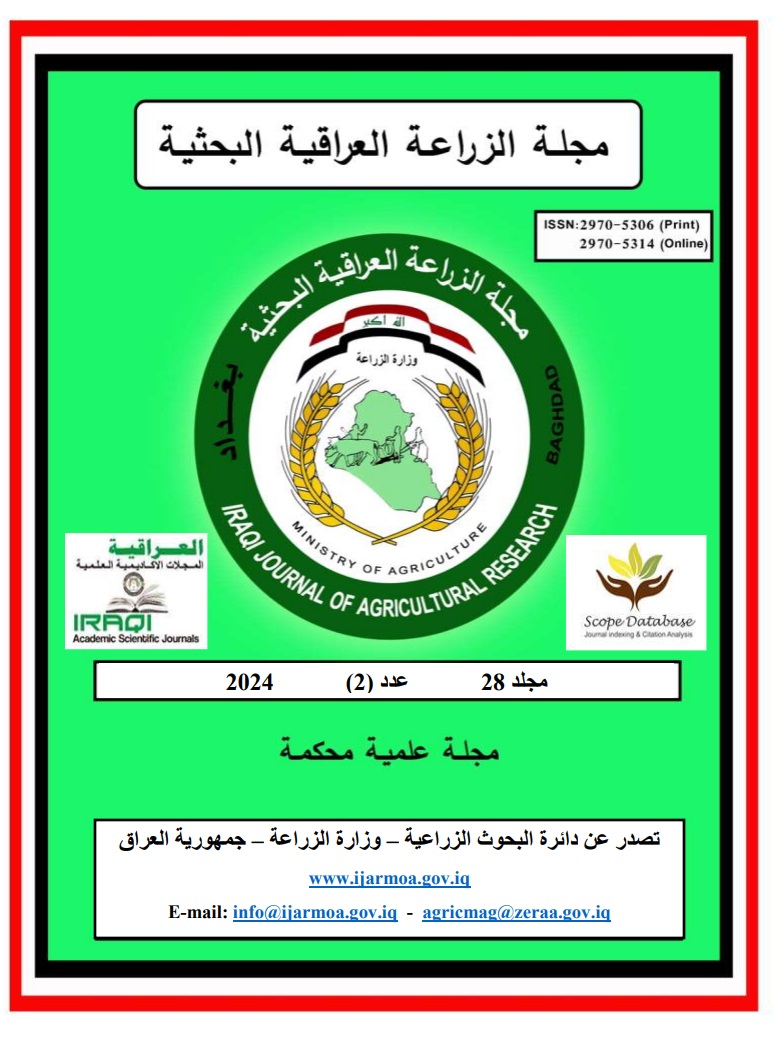Abstract
A potting experiment was carried out in the plastic house using soil with a loam texture, for the purpose of studying the process of phytoremidation of soil contaminated with some heavy metals (Plumbum, Cadmium, and Nickel) using three ornamental plants: Ficu elastica (Fix) and Catharanthus vinca and Carissa, to evaluate the efficiency of above ornamental plants in absorbing and accumulating heavy metals from soil contaminated with them. Evaluation of soil and plant contamination with heavy metals based on concentration according to international standards. Seedlings of ornamental plants were planted at the same age and were fertilized with NPK elements according to the fertilizer recommendation. It was irrigated with tap water after depleting 35% of the prepared water. The experiment continued for four months and was carried out according to a completely randomized design (CRD) using three ornamental plants and three levels of three heavy metals Pb, Cd, and Ni are 0, 100, and 200 mg L-1 for Plumbum, 0, 10 and 15 mg L-1 for Cadmium, and 0, 50 and 100 mg L-1 for Nickel with four replications to make a number of experimental units 108. Soil samples were taken and after the end of the experiment, available and total heavy metals were estimated. Plant samples (leaves) were also taken after the end of the experiment, and concentrations of heavy metals were estimated. Results showed an increase in total and available concentrations of heavy metals in cultivated soil for all plants after the end of the experiment, directly with an increase in levels of added heavy metals. Plumbum, Cadmium, and Nickel (32.27, 28.62, and 33.56), (1.593, 1.009, 1.326) and (12.17, 8.41, and 10.61) mg kg-1 for heavy metals, respectively, for Ficus elastica (Fix) and Catharanthus vinca and Carissa, respectively. Plants can be arranged in terms of their efficiency in absorbing heavy metals as follows: Catharanthus vinca > Carissa > Ficus elastica, which indicates the high ability of plants to transport and accumulate heavy metals from soil to plant. Heavy elements can arrange according to the amount absorbed from them as follows: - Cadmium > Nickel > Plumbum
Keywords
biological reclamation
Heavy Elements
Ornamental Plants
polluted soil
Abstract
لغرض دراسة تقييم تلوث التربة والنبات ببعض العناصر الثقيلة (Ni , Cd , Pb) وفق معايير التلوث العالمية. اجريت تجربة اصص في البيت البلاستيكي باستعمال تربة ذات نسجة مزيجية باستعمال ثلاثة نباتات زينة هي المطاط الصيني (الفيكس) وعين البزون والكاريزيا، زرعت شتلات نباتات الزينة بعمر واحد (ثلاثة اشهر) وتم التسميد بعناصر NPK حسب التوصية السمادية ورويت بمياه الحنفية بعد استنفاذ 35% من الماء الجاهز واستمرت التجربة لمدة اربعة اشهر. نفذت التجربة عامليا وفق تصيمم تام التعشية (CRD) باستعمال ثلاثة نباتات زينة وثلاثة مستويات من ثلاثة عناصر ثقيلة Pb و Cd و Ni هي 0 و 100 و 200 ملغم.لتر-1 للرصاص و 0 و10 و15 ملغم.لتر-1 للكادميوم و0 و50 و100 ملغم.لتر-1 للنيكل بأربعة مكررات ليصبح عدد الوحدات التجريبية 108. اخذت عينات تربة قبل وبعد نهاية التجربة وتم تقدير العناصر الثقيلة الجاهزة والكلية، كما اخذت نماذج نباتية (الجذر والاوراق) بعد نهاية التجربة، وقدرت فيها تراكيز العناصر الثقيلة. بينت النتائج زيادة التراكيز الكلية للعناصر الثقيلة في التربة المزروعة وللنباتات كافة بعد نهاية التجربة طرديا مع زيادة مستويات العناصر الثقيلة المضافة، اذ بلغت التراكيز الكلية لعناصر الرصاص والكادميوم والنيكل (32.27 و28.62 و 33.56) و (1.593 و 1.009 و 1.326) و (12.17 و 8.41 و 10.61) ملغم.كغم-1 للعناصر الثقيلة ولنباتات المطاط الصيني وعين البزون والكاريزيا على التوالي، وجود اعلى تلوثاً بيئياً في التربة المزروعة بنباتات الزينة جميعها، كما وجدت اعلى القيم لمؤشر الخطر البيئي في التربة. يمكن ترتيب النباتات من حيث كفاءها في امتصاص العناصر الثقيلة كما يلي: نبات عين البزون > الكاريزيا > المطاط الصيني، مما يشير الى قدرة النباتات العالية في نقل وتراكم العناصر الثقيلة من التربة الى النبات. اما العناصر الثقيلة فيمكن ترتيبها حسب الكمية الممتصة منها كما يأتي: -الكادميوم > النيكل > الرصاص
Keywords
التربة الملوثة، معايير التلوث العالمية، العناصر الثقيلة، نباتات الزينة
